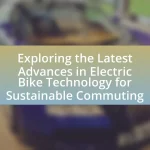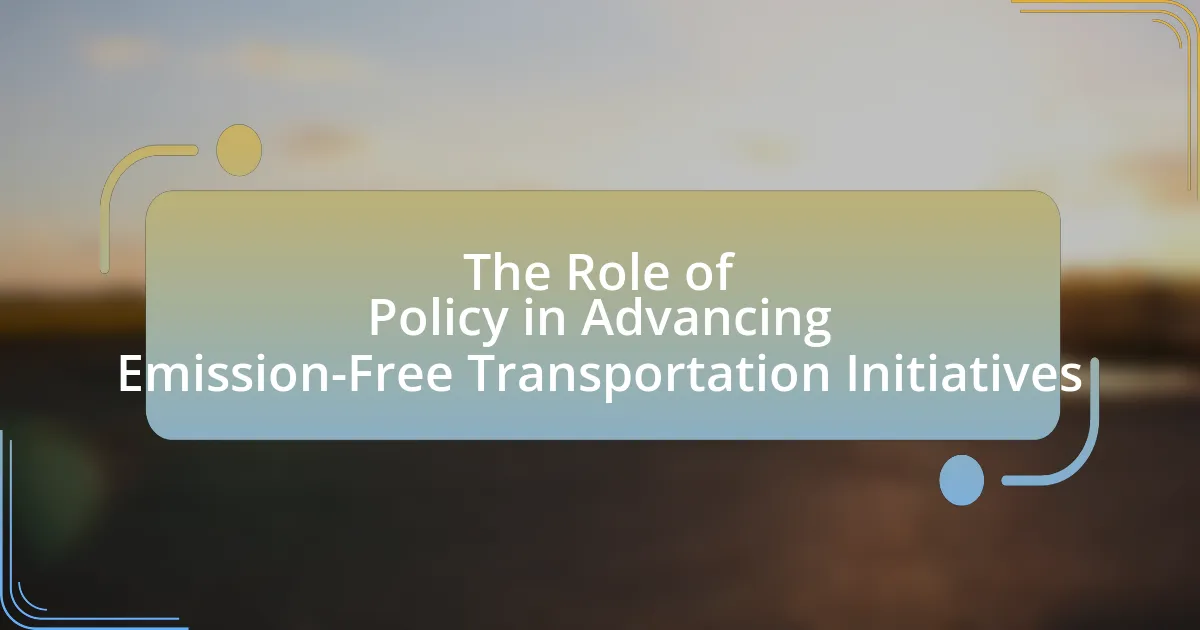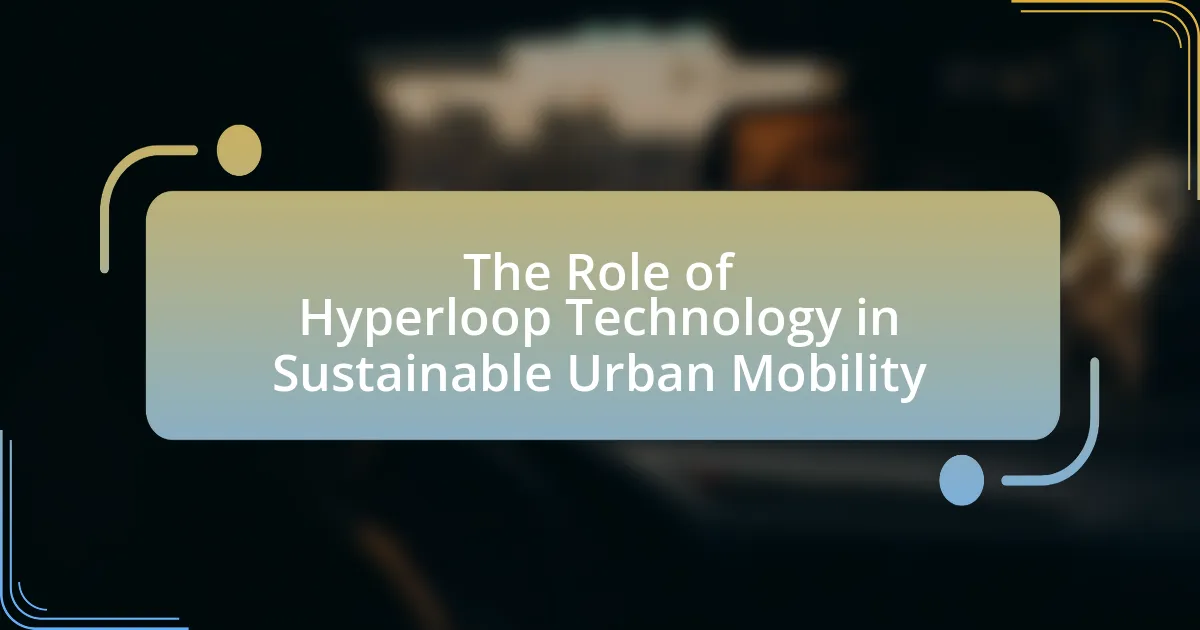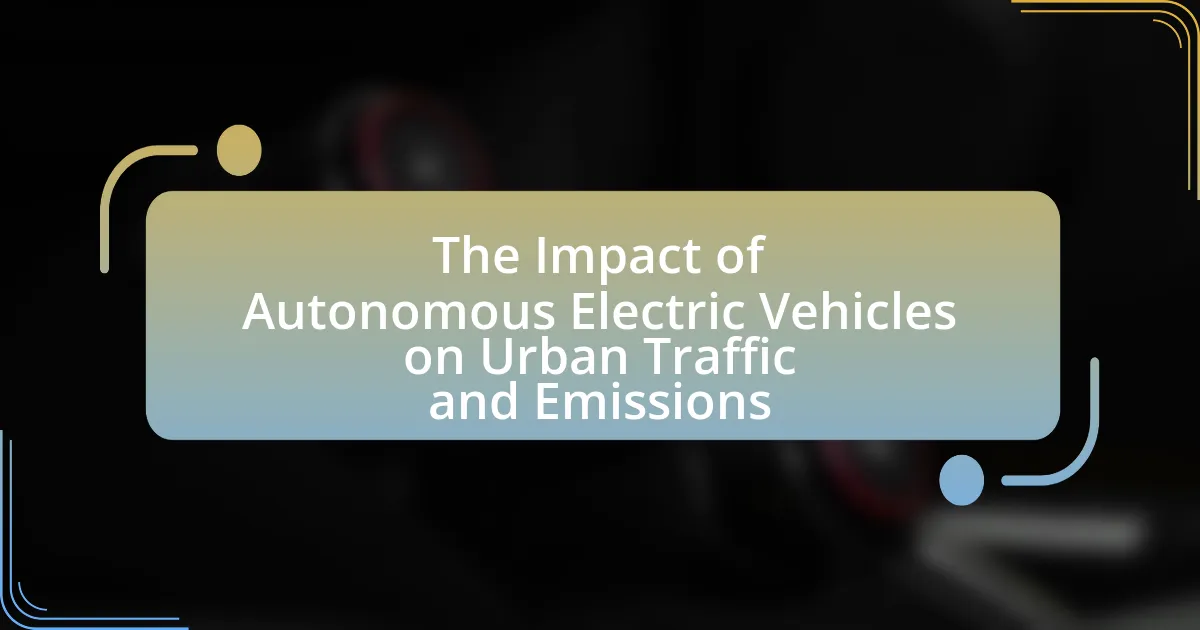Innovations in urban planning for promoting emission-free mobility focus on developing integrated public transportation systems, pedestrian-friendly infrastructure, and smart city technologies. These innovations aim to reduce reliance on fossil fuel-powered vehicles, thereby decreasing greenhouse gas emissions and improving air quality. Key strategies include expanding cycling networks, enhancing public transit, and integrating electric vehicle infrastructure. The article also addresses the environmental and public health benefits of emission-free mobility, the role of renewable energy, and the challenges cities face in implementing these initiatives. Additionally, it highlights the importance of community engagement and effective policies to support sustainable urban mobility solutions.

What are Innovations in Urban Planning for Promoting Emission-Free Mobility?
Innovations in urban planning for promoting emission-free mobility include the development of integrated public transportation systems, pedestrian-friendly infrastructure, and the implementation of smart city technologies. Integrated public transportation systems, such as bus rapid transit and light rail, reduce reliance on personal vehicles, thereby decreasing emissions. Pedestrian-friendly infrastructure, including expanded sidewalks and bike lanes, encourages walking and cycling, which are zero-emission modes of transport. Smart city technologies, such as real-time traffic management and electric vehicle charging networks, facilitate efficient mobility solutions and support the transition to electric vehicles. These innovations collectively contribute to sustainable urban environments and align with global efforts to reduce greenhouse gas emissions.
How do these innovations impact urban environments?
Innovations in urban planning for promoting emission-free mobility significantly enhance urban environments by reducing air pollution and improving public health. For instance, the implementation of electric public transportation systems and dedicated cycling lanes decreases reliance on fossil fuel-powered vehicles, leading to lower greenhouse gas emissions. According to a study by the International Council on Clean Transportation, cities that adopted electric buses saw a reduction in particulate matter and nitrogen oxides, contributing to better air quality. Additionally, these innovations foster sustainable urban design, encouraging walkable neighborhoods and green spaces, which enhance the quality of life for residents.
What specific urban planning strategies are being implemented?
Specific urban planning strategies being implemented include the development of pedestrian-friendly infrastructure, the expansion of cycling networks, and the integration of public transportation systems. These strategies aim to reduce reliance on fossil fuel-powered vehicles, thereby promoting emission-free mobility. For instance, cities like Amsterdam have successfully increased cycling by creating dedicated bike lanes and bike-sharing programs, resulting in a significant decrease in carbon emissions. Additionally, the implementation of mixed-use developments encourages walkability and reduces travel distances, further supporting sustainable urban mobility.
How do these strategies contribute to emission-free mobility?
Strategies in urban planning, such as the development of pedestrian-friendly infrastructure, enhanced public transportation systems, and the promotion of electric vehicle usage, significantly contribute to emission-free mobility. By prioritizing walkability and cycling, cities reduce reliance on fossil fuel-powered vehicles, leading to lower greenhouse gas emissions. For instance, cities that have implemented extensive bike lanes and pedestrian zones, like Copenhagen, have seen a substantial increase in non-motorized transport, which accounts for over 62% of all trips. Additionally, integrating electric vehicle charging stations into urban design encourages the adoption of electric vehicles, further decreasing emissions. These strategies collectively foster a sustainable urban environment, promoting cleaner air and reducing the carbon footprint associated with transportation.
Why is emission-free mobility important in urban planning?
Emission-free mobility is crucial in urban planning because it significantly reduces air pollution and greenhouse gas emissions, contributing to improved public health and environmental sustainability. Urban areas are often characterized by high traffic volumes, which lead to elevated levels of harmful pollutants; for instance, transportation accounts for approximately 29% of total greenhouse gas emissions in the United States. By prioritizing emission-free transportation options, such as electric vehicles, public transit, and cycling infrastructure, cities can enhance air quality, decrease noise pollution, and promote a healthier lifestyle for residents. Furthermore, integrating emission-free mobility into urban planning supports climate change mitigation efforts, aligning with global targets to limit temperature rise and foster sustainable urban development.
What are the environmental benefits of emission-free mobility?
Emission-free mobility significantly reduces air pollution and greenhouse gas emissions. By eliminating harmful emissions from vehicles, it contributes to improved air quality, which is linked to better public health outcomes. For instance, a study by the International Council on Clean Transportation found that transitioning to electric vehicles could reduce urban air pollutants by up to 90%, leading to a decrease in respiratory diseases and related healthcare costs. Additionally, emission-free mobility supports climate change mitigation efforts by lowering carbon dioxide emissions, which are a major contributor to global warming. According to the U.S. Environmental Protection Agency, transportation accounts for approximately 29% of total greenhouse gas emissions, highlighting the potential impact of adopting emission-free transportation solutions.
How does emission-free mobility affect public health?
Emission-free mobility positively affects public health by reducing air pollution and associated health risks. Studies indicate that transitioning to electric vehicles and other emission-free transportation options can significantly lower levels of harmful pollutants such as nitrogen oxides and particulate matter, which are linked to respiratory diseases and cardiovascular issues. For instance, research published in the journal “Environmental Health Perspectives” found that reducing vehicle emissions could prevent thousands of premature deaths annually by improving air quality. Additionally, emission-free mobility encourages active transportation modes like walking and cycling, which contribute to physical fitness and mental well-being.

What technologies are driving innovations in urban planning?
Technologies driving innovations in urban planning include Geographic Information Systems (GIS), smart sensors, and data analytics. GIS enables planners to visualize and analyze spatial data, facilitating informed decision-making regarding land use and infrastructure. Smart sensors collect real-time data on traffic patterns, air quality, and energy consumption, allowing for responsive urban management. Data analytics processes this information to identify trends and optimize resource allocation, enhancing the efficiency of urban systems. These technologies collectively support the development of sustainable, emission-free mobility solutions by improving urban design and transportation planning.
How do smart transportation systems enhance urban mobility?
Smart transportation systems enhance urban mobility by optimizing traffic flow and reducing congestion through real-time data analysis and communication technologies. These systems utilize sensors, GPS, and artificial intelligence to monitor traffic patterns, enabling dynamic routing and efficient public transit schedules. For instance, cities implementing smart traffic signals can reduce wait times by adjusting signal timings based on current traffic conditions, leading to a reported 20-30% decrease in travel time. Additionally, smart transportation systems promote the use of alternative modes of transport, such as bike-sharing and electric vehicles, which contribute to lower emissions and improved air quality. Studies show that cities with integrated smart transportation solutions experience a significant increase in public transit usage, further enhancing urban mobility.
What role does data analytics play in urban planning?
Data analytics plays a crucial role in urban planning by enabling data-driven decision-making that enhances efficiency and sustainability. Urban planners utilize data analytics to analyze traffic patterns, population density, and land use, which informs the design of transportation systems and infrastructure. For instance, cities like Barcelona have implemented data analytics to optimize public transport routes, resulting in a 10% increase in ridership. Additionally, predictive analytics helps in forecasting future urban growth and environmental impacts, allowing for proactive measures in promoting emission-free mobility. This integration of data analytics not only improves urban livability but also supports the transition to sustainable urban environments.
How are electric vehicles integrated into urban infrastructure?
Electric vehicles are integrated into urban infrastructure through the development of charging stations, dedicated lanes, and smart grid technology. Cities are increasingly installing public charging stations in strategic locations such as parking lots, shopping centers, and along major roadways to facilitate easy access for EV users. For instance, as of 2023, over 100,000 public charging points have been established across the United States, promoting the adoption of electric vehicles. Additionally, urban planners are designing dedicated lanes for electric vehicles to enhance traffic flow and safety. Smart grid technology is also being implemented to manage energy distribution efficiently, allowing for the integration of renewable energy sources to power these vehicles. This comprehensive approach supports the transition to emission-free mobility by ensuring that the necessary infrastructure is in place to accommodate the growing number of electric vehicles on the road.
What role do renewable energy sources play in urban mobility?
Renewable energy sources play a crucial role in urban mobility by providing sustainable power for transportation systems, thereby reducing greenhouse gas emissions. The integration of electric vehicles (EVs) powered by solar, wind, and hydroelectric energy contributes to cleaner air and lower carbon footprints in urban areas. For instance, a study by the International Energy Agency (IEA) indicates that transitioning to electric mobility could reduce global CO2 emissions from road transport by up to 70% by 2050 if powered by renewable energy. This shift not only enhances energy efficiency but also promotes energy independence and resilience in urban transport networks.
How can solar energy be utilized in urban transport systems?
Solar energy can be utilized in urban transport systems through the integration of solar panels in public transportation infrastructure, such as buses, trams, and train stations. This approach allows for the generation of renewable energy that can power electric vehicles, reducing reliance on fossil fuels. For instance, solar-powered buses can operate with minimal emissions, contributing to cleaner air in urban areas. Additionally, solar energy can be harnessed to charge electric vehicle (EV) charging stations, promoting the use of EVs among commuters. According to the International Energy Agency, solar energy has the potential to significantly reduce greenhouse gas emissions in the transport sector, aligning with global sustainability goals.
What are the benefits of using wind energy in urban planning?
The benefits of using wind energy in urban planning include reduced greenhouse gas emissions, enhanced energy security, and economic savings. Wind energy contributes to lowering carbon footprints by providing a clean, renewable source of power, which is essential for combating climate change. According to the U.S. Department of Energy, wind energy can reduce carbon dioxide emissions by approximately 329 million metric tons annually, equivalent to the emissions from 70 million cars. Additionally, integrating wind energy into urban infrastructure can lead to energy independence, as cities can generate their own electricity, reducing reliance on fossil fuels. Furthermore, the operational costs of wind energy are decreasing; the levelized cost of energy from onshore wind has dropped by 70% since 2009, making it a financially viable option for urban planners.

What challenges do cities face in implementing these innovations?
Cities face significant challenges in implementing innovations for promoting emission-free mobility, primarily due to funding constraints, regulatory hurdles, and public resistance. Funding limitations often hinder the ability to invest in necessary infrastructure, such as electric vehicle charging stations and dedicated bike lanes. Regulatory hurdles arise from outdated policies that may not accommodate new technologies or practices, complicating the approval process for innovative projects. Additionally, public resistance can stem from a lack of awareness or understanding of the benefits of emission-free mobility, making it difficult to gain community support for such initiatives. These challenges collectively impede the effective integration of sustainable transportation solutions in urban environments.
How can funding and investment impact urban planning initiatives?
Funding and investment significantly influence urban planning initiatives by providing the necessary financial resources to implement projects and innovations. For instance, cities that allocate substantial funding towards sustainable transportation infrastructure, such as bike lanes and electric vehicle charging stations, can effectively promote emission-free mobility. A study by the American Public Transportation Association found that every $1 invested in public transportation generates approximately $4 in economic returns, highlighting the financial benefits of investing in urban mobility initiatives. Additionally, targeted investments can enhance public spaces and green areas, improving overall urban livability and reducing carbon footprints.
What are the common funding sources for emission-free mobility projects?
Common funding sources for emission-free mobility projects include government grants, private investments, public-private partnerships, and international funding organizations. Government grants often come from federal, state, or local agencies aimed at reducing carbon emissions and promoting sustainable transportation. Private investments are typically made by venture capital firms or corporations interested in green technologies. Public-private partnerships leverage resources from both sectors to finance large-scale projects. International funding organizations, such as the World Bank or the European Investment Bank, provide financial support for initiatives that align with global sustainability goals. These funding sources are essential for advancing emission-free mobility solutions and achieving urban planning objectives focused on sustainability.
How can public-private partnerships facilitate urban planning innovations?
Public-private partnerships (PPPs) can facilitate urban planning innovations by leveraging resources, expertise, and funding from both sectors to implement sustainable mobility solutions. These collaborations enable the development of integrated transportation systems that prioritize emission-free options, such as electric public transit and bike-sharing programs. For instance, the partnership between the city of Los Angeles and private companies has led to the expansion of electric vehicle charging infrastructure, significantly enhancing the city’s capacity to support emission-free mobility. Additionally, PPPs can foster innovation through shared risk and investment, allowing for pilot projects that test new technologies and approaches in urban planning, ultimately leading to more efficient and environmentally friendly urban environments.
What social and political barriers exist in promoting emission-free mobility?
Social and political barriers in promoting emission-free mobility include resistance from established industries, lack of political will, and public skepticism. Established industries, particularly fossil fuel and automotive sectors, often lobby against policies favoring emission-free alternatives, hindering legislative progress. Lack of political will is evident in insufficient funding and support for infrastructure development, as seen in many regions where electric vehicle charging stations remain sparse. Public skepticism arises from concerns about the practicality and cost of emission-free technologies, which can be observed in survey data indicating that a significant portion of the population remains hesitant to adopt electric vehicles due to perceived limitations.
How can community engagement improve urban planning outcomes?
Community engagement can significantly improve urban planning outcomes by ensuring that the needs and preferences of residents are incorporated into the planning process. When communities actively participate, planners gain valuable insights into local issues, which leads to more relevant and effective solutions. For instance, a study by the American Planning Association found that projects with community involvement are 30% more likely to succeed in meeting their objectives. Engaging residents fosters a sense of ownership and accountability, which can enhance the sustainability of urban initiatives. Additionally, community feedback can help identify potential challenges early, allowing for adjustments that align with public expectations and ultimately result in more successful urban environments.
What policies are necessary to support emission-free mobility initiatives?
Policies necessary to support emission-free mobility initiatives include financial incentives, infrastructure development, and regulatory frameworks. Financial incentives, such as subsidies for electric vehicles and tax breaks for companies investing in clean transportation, encourage adoption. Infrastructure development, including charging stations and dedicated lanes for electric vehicles, facilitates the transition to emission-free options. Regulatory frameworks, such as emissions standards and low-emission zones, create a legal environment that promotes sustainable mobility practices. These policies collectively drive the shift towards emission-free transportation, as evidenced by cities like Oslo, which implemented such measures and saw a significant increase in electric vehicle usage.
What best practices can cities adopt for successful implementation?
Cities can adopt best practices such as stakeholder engagement, data-driven decision-making, and integrated planning for successful implementation of emission-free mobility initiatives. Stakeholder engagement ensures that the needs and perspectives of residents, businesses, and community organizations are considered, fostering public support and collaboration. Data-driven decision-making involves utilizing analytics and real-time data to inform policies and track progress, which enhances accountability and effectiveness. Integrated planning combines transportation, land use, and environmental policies to create cohesive strategies that promote sustainable mobility solutions. These practices have been shown to improve project outcomes, as evidenced by successful case studies in cities like Copenhagen and Amsterdam, where comprehensive planning and community involvement led to significant reductions in emissions and increased use of public transport and cycling.
How can cities effectively measure the success of their initiatives?
Cities can effectively measure the success of their initiatives by utilizing key performance indicators (KPIs) that align with their specific goals. For instance, cities can track metrics such as reductions in greenhouse gas emissions, increases in public transportation usage, and improvements in air quality to evaluate the impact of emission-free mobility initiatives. Research conducted by the Institute for Transportation and Development Policy indicates that cities implementing comprehensive mobility plans saw a 20% increase in public transit ridership over five years, demonstrating a clear correlation between targeted initiatives and measurable outcomes. By systematically collecting and analyzing data related to these KPIs, cities can assess the effectiveness of their strategies and make informed adjustments to enhance future initiatives.
What lessons can be learned from cities that have successfully implemented emission-free mobility solutions?
Cities that have successfully implemented emission-free mobility solutions demonstrate several key lessons. First, comprehensive planning and integration of various transport modes are essential; for instance, cities like Amsterdam and Copenhagen have effectively combined cycling infrastructure with public transport systems, leading to increased usage of emission-free options. Second, investment in infrastructure, such as dedicated bike lanes and charging stations for electric vehicles, significantly enhances the viability of these solutions, as seen in cities like Oslo, which has seen a 30% increase in electric vehicle usage due to extensive charging networks. Third, public engagement and education are crucial; cities that actively involve residents in the planning process, like Freiburg, foster greater acceptance and usage of emission-free mobility. Lastly, implementing policies that incentivize the use of emission-free transport, such as subsidies for electric vehicles and congestion pricing, has proven effective in cities like London, which has reduced emissions by 20% since the introduction of its Ultra Low Emission Zone.





